Find Replace
FindReplace Art
Finding Art Panel
Replacing Art Panel
Art Switcher
Illustrator Location:
Illustrator Main Menu > Window > Astute Graphics > FindReplace Art
The menu item to show and hide the FindReplace Art panel can be found in the main menu under Window > Astute Graphics > FindReplace Art.
The FindReplace Art panel is large, and dynamically changes its appearance depending on which kind of art and which attributes are selected. A representative view is shown below, set up to search for hexagonally-shaped paths with green fills and replace them with either a green triangle or yellow circle:
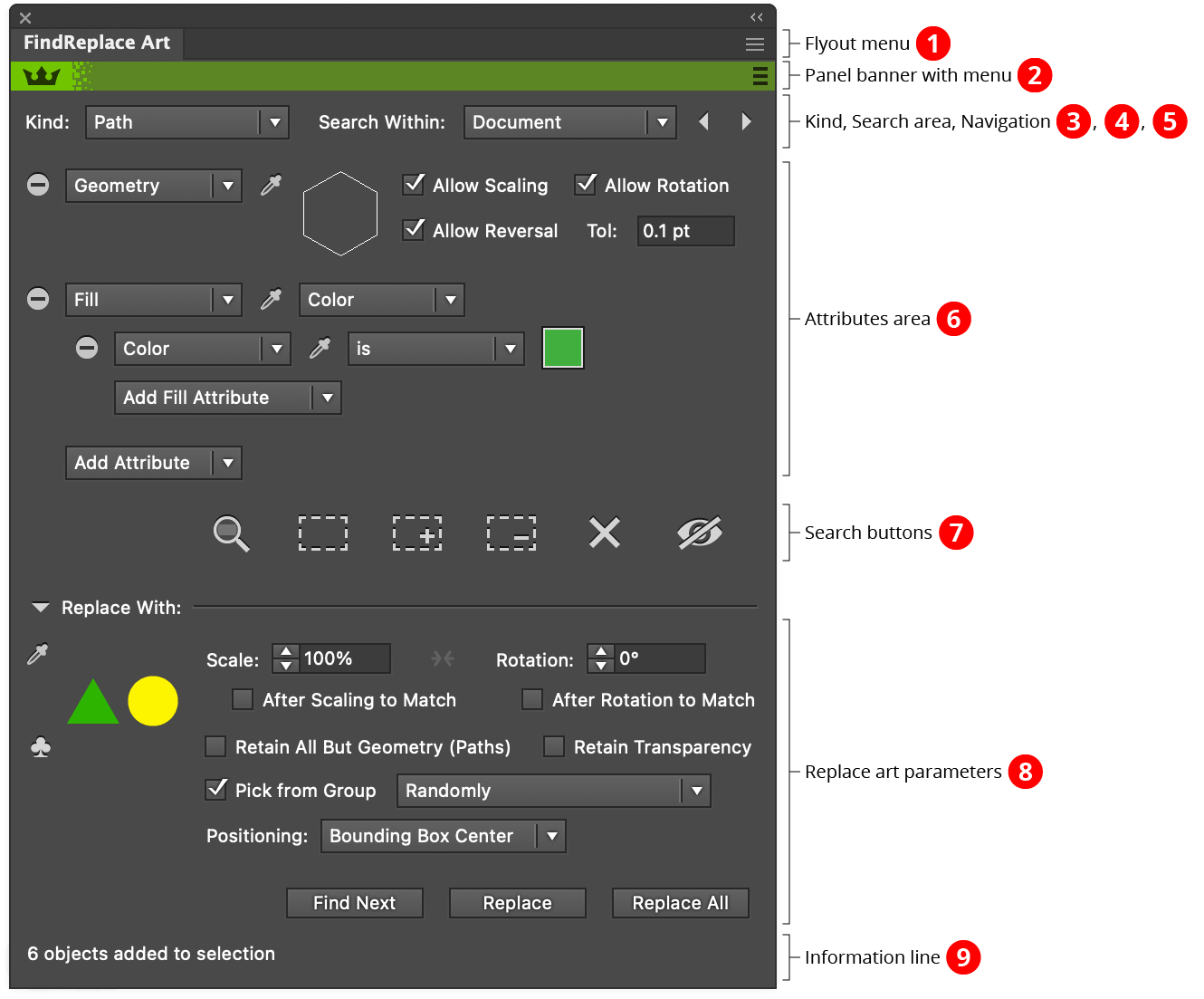
FindReplace Art Panel Overview
1. Flyout menu
See FindReplace Art Panel: Flyout Menu.
2. Panel banner
The help button on the right opens the help documentation in the Astute Manager. If this does not automatically appear, please ensure your Astute Manager is running first.
3. Kind
Sets the kind of object to search for, from among the following: Any, Group, Path, Guide, Raster (embedded), Linked, Symbol, Text, Mesh, Blend, Live Paint, Envelope, Symbol Set, Compound Shape, Space Fill, and Width Stamp. Kind is the fundamental search parameter, because the attributes that are available to narrow down the search depends on the Kind. For example, both path art and raster art can be searched for based on the attribute Opacity, but only raster art has a Resolution attribute.
4. Search area
Sets the place to search within, from among the following: Document, Current Artboard, Current Layer, and Selection. This parameter is not part of a saved Search, but is retained until it is changed.
5. Navigation
The previous and next buttons let you step through the current history of completed searches. Searches are considered complete when one of the search buttons is pressed. The size of the search history is specifiable in the panel preferences. Searches can also be saved with a specific name and recalled.
6. Attributes Area
This variable-size area displays various art attributes, which refine the search. An art object must match all attributes to be successfully found. Attributes are added by using the contextual Add Attribute pop-up menu at the bottom of the Attributes area. Attributes in this menu that are above the divider line (if any) are specific to the art kind; those below the line are available for any art kind. For example, the attributes menu for Path art is:

FindReplace Art Path Attributes Menu
Some attributes have sub-attributes that can be added; in these cases a separate pop-up menu will be displayed indented and below the added attribute.
Each attribute or sub-attribute contains its own controls used to specify its parameters. These always includes an eyedropper icon, which is used to pick up the values from the currently selected art (when possible). For attributes which do not represent a range of numerical values, such as Path: Type (i.e., open or closed), the eyedropper will be disabled if the selection contains more than a single value. For values which do have a range, pressing Option/Alt while clicking the eyedropper will add a small “clearance” to the values, using the clearance value in the panel preferences. For example, if the clearance is set to 5%, then picking up the value of 100 would automatically change the minimum to 95 and the maximum to 105.
Attributes can be removed by clicking the small “circle with minus sign” icon to the left of that attribute. Removing an attribute automatically removes any sub-attributes associated with it.
See FindReplace Art: Search Attributes for more information and a complete list of attributes.
7. Search Buttons
All the buttons perform the same search specified in the upper part of the panel; they differ in that each does something different with the located art.

FindReplace Art Panel Search Buttons
A. Locate Next Matching Art: Highlights the first matching art object in the color specified in the panel preferences. If more than one art object was matched, repeated clicks will highlight each one in turn. By default, the document will be scrolled so that the matching art is centered in the document window, but this behavior can be disabled in the panel preferences.

Option/Alt-clicking on the button steps through the matching objects in reverse order. Shift-clicking will highlight all of the matching art objects at once.
B. Select Matching Art: Replaces the current selection (if any) with one containing only the matching art. Option/Alt-clicking on the button selects only a random subset of the matching art.
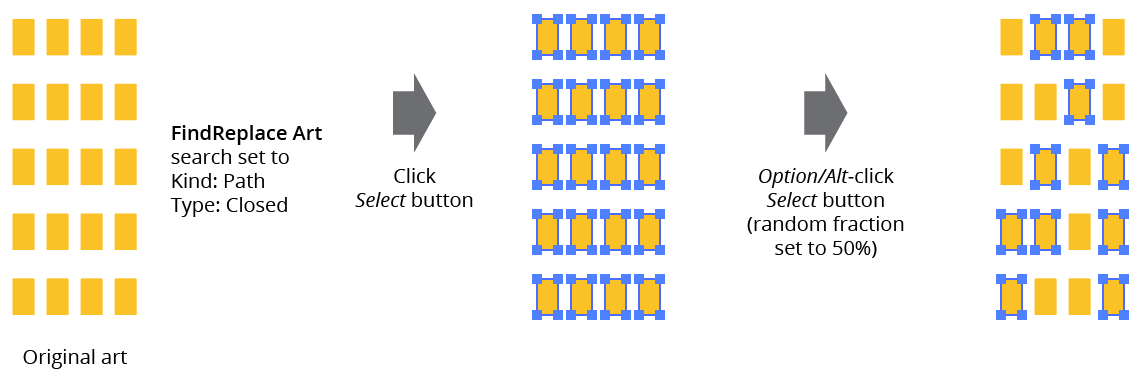
FindReplace Art Select Examples
To change the random fraction, Shift+Option/Alt-click to bring up the following dialog:
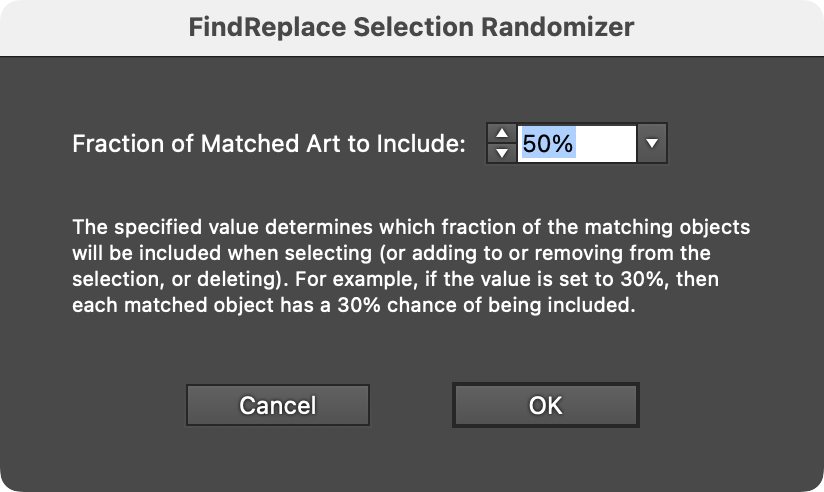
FindReplace Art Selection Randomizer Dialog
C. Add Matching Art to Selection: Adds matching art to the current selection, if any. Option/Alt-clicking on the button adds only a random subset of the matching art.
D. Remove Matching Art from Selection: Removes matching art from the current selection, if any. Option/Alt-clicking on the button removes only a random subset of the matching art.
E. Delete Matching Art: Deletes the matching art. Option/Alt-clicking on the button deletes only a random subset of the matching art.
F. Hide Matching Art: Hides the matching art. To hide the non-matching art instead, Shift-click the button.
8. Replace Art Parameters
Allows art which is matches the search in the top section of the panel to be replaced by different art. See FindReplace Art: Replacing Art for examples and details about each control.
9. Information Line
Displays status information, such as the number of art objects found or replaced, or confirmations such as when replacement art is picked up using the eyedropper.
Illustrator Location:
Illustrator Main Menu > Window > Astute Graphics > FindReplace Art
The following attributes can be specified in a search regardless of the art’s kind:
1. Opacity
The range of the overall opacity of the art, as specified in the native Transparency panel. To search for art which has any non-solid opacity, use 0% for the minimum and 99.9% for the maximum.

FindReplace Art Opacity Controls
2. Blend Mode
The blend mode of the art, from among the sixteen modes available in the native Transparency panel. Matching options include is and is not the specified mode.

FindReplace Art Blend Mode Controls
3. Opacity Mask
Whether the art contains an opacity mask (as applied in the native Transparency panel).

FindReplace Art Opacity Mask Controls
4. Linear Extent
The size of the art, defined as the larger of either the height or width of its bounding box. Unless the art kind is set to Group, linear extent looks at each group member individually.

FindReplace Art Linear Extent Controls
5. Grouped
Whether or not the art is a member of a group (including a clipping set, which is internally also a group). Note that if the art kind is set to Any, searching for art which is not grouped will still find the top-level groups themselves.

FindReplace Art Grouped Controls
6. Clipped
Whether or not the art is being clipped (is a member of a clipping set).

FindReplace Art Clipped Controls
7. Effects
Matches live effects that are applied to the object. Choices include Any (matched when the art has any live effect at all applied to it); None; Missing (matched when the art has an effect that is controlled by a plugin that is not loaded, and therefore cannot be edited); Multiple (matched if the art has more than one live effect applied to it); or the name of a specific live effect. Although not every live effect is searchable, the common ones are.

FindReplace Art Effects Controls
8. Name
The name of the art object, as displayed in the native Layers panel. Matching options include is default (the art still has the default name assigned by Illustrator); is not default (the art has been manually renamed); and the following string operations with a specifiable string: is, is not, contains, does not contain, starts with, does not start with, ends with, and does not end with.

FindReplace Art Name Controls
Illustrator Location:
Illustrator Main Menu > Window > Astute Graphics > FindReplace Art
The following attributes can be specified in a search when the art kind is set to Group:
1. Clipping
Whether the group is a clip group (also called a clipping set).

FindReplace Art Group Clipping Controls
2. Depth
The level to which the group is nested. For example, a group inside another group would have a depth of 2. Groups in Illustrator are limited to a depth of 28.

FindReplace Art Group Depth Controls
3. Size
The size of the group; i.e., the number of immediate child members that it contains. If one of the children is another group, the size of that group is not carried up to the top-level group. In other words, a group which consists of two paths plus a group always has a size of 3, regardless of the number of children in the nested group.

FindReplace Art Group Size Controls
4. Members
The kind of art contained in the group, either as immediate child members or in nested groups. You can specify that the group members need to include the kind, do not include it, or are all composed of that kind.

FindReplace Art Group Members Controls
Illustrator Location:
Illustrator Main Menu > Window > Astute Graphics > FindReplace Art
The following attributes can be specified in a search when the art kind is set to Path:
1. Type
Whether the path is open or closed. When applied to a compound path, all the subpaths must match for the compound path to match.

FindReplace Art Path Type Controls
2. Compound
Whether the path is a compound in its entirety, is the subpath of a compound path, or is neither.

FindReplace Art Path Compound Controls
3. Clipping
Whether the path is a clipping path or not.

FindReplace Art Path Clipping Controls
4. Point Count
The number of anchor points in the path. When applied to a compound path, all the subpaths must match for the compound path to match. Paths can have a maximum of 32000 points.

FindReplace Art Path Point Count Controls
5. Bezier Handles
Whether or not the path contains bezier segments with handles, which, generally, implies a path that has curves.

FindReplace Art Path Bezier Handles Controls
6. Length
The length of the path, as measured “along the curve”. When applied to a compound path, all the subpaths must match for the compound path to match.

FindReplace Art Path Length Controls
7. Shape
Allows matching one of six different primitive shapes. Unlike the Geometry attribute, Shape can match multiple aspect ratios (for rectangles and ellipses) and allows for one or more rounded corners.

FindReplace Art Path Shape Controls
A. Shape Type: From among Square, Circle, Rectangle, Ellipse, Polygon, and Star.
B. Rounded Corners: Available unless the Type is set to Circle or Ellipse. Specifies whether the matching paths must have one or more rounded corners or not.
C. Tolerance: Specifies how close the matching paths must be to the “ideal” shape. Higher values mean shapes which have anchor points and handles in positions which are further and further from “ideal” will still be matched.
D. Sides/Points: Available for Polygon and Star; specifies the number of sides (for polygons) or points (for stars) must have, from 3 to 100.
8. Geometry
The actual shape of the path.

FindReplace Art Path Geometry Controls
A. Preview Chip: Shows a preview of the geometry that must be matched. This must be picked up from an existing path using the eyedropper next to it. Note that anchor point placement is not shown. Clicking on the chip switches its background between white and the panel background color.
B. Allow Scaling: Specifies whether paths which have the same shape, but are larger or smaller than the path which was picked up, should also be considered matches.
C. Allow Rotation: Specifies whether paths which have the same shape, but are rotated with respect to the path which was picked up, should also be considered matches.
D. Allow Reversal: Specifies whether paths which have the same shape, but go in the opposite direction from the path which was picked up, should also be considered matches.
E. Tolerance: The distance which anchor point and handle on the path can differ from their “ideal” placement and still be considered the same. The default value is 0.1 pt.
9. Stroke
The stroke(s) on the path. Possible options include:
A. Any: Matches paths which have one or more strokes of any kind (flat color, gradient, or pattern).
B. None: Matches paths which have no stroke.
C. Color: Matches paths which have one or more strokes containing a flat color.
D. Gradient: Matches paths which have one or more strokes containing a gradient.
E. Pattern: Matches paths which have one or more strokes containing a pattern.
F. Multiple: Matches paths which have more than one stroke, as indicated in the appearance panel.

FindReplace Art Path Stroke Controls
Unless the stroke attribute is set to None or Multiple, additional stroke sub-attributes may be added using the popup menu which will appear below the main attribute. If the path contains multiple strokes, it will match if any of the strokes match all the stroke sub-attributes. Possible options include:
A. Color: The color assigned to the stroke, which can be matched using the following specifiers: is, is not, is close to, is not close to, Any process, and Any spot. The color itself can be picked up from existing art using the eyedropper or by clicking on the color chip to bring up the native Color Picker. When using is close to or is not close to, the degree of similarity is specified using the Close Color Tolerance value specified in the panel preferences. When specifying a spot color, the tint of the spot color may be included in the search. When the stroke attribute is set to Color, Shift-clicking its eyedropper automatically adds the Color sub-attribute and sets the color value.

Stroke Color Controls
B. Gradient: The gradient assigned to the stroke, which can be matched using the following specifiers: is, is not, Any linear, and Any radial. The gradient itself can be picked up from existing art using the eyedropper or by clicking on the gradient chip to bring up the Gradient Picker dialog (see FindReplace Art: Gradient and Pattern Pickers).

Stroke Gradient Controls
C. Gradient Method: Available for Illustrator 2026 and up. The method of the stroke gradient, either Classic or Perceptual.

Stroke Gradient Method Controls
D. Gradient Mode: The mode of the stroke gradient, either Within stroke, Along stroke, or Across stroke (as specified in the native Gradient panel) assigned to the stroke, which can be matched using either is, or is not.

Stroke Gradient Mode Controls
E. Pattern: The pattern assigned to the stroke, which can be matched using either is, or is not. The pattern itself can be picked up from existing art using the eyedropper or by clicking on the pattern chip to bring up the Pattern Picker dialog.

Stroke Pattern Controls
F. Weight: The weight of the stroke.

Stroke Weight Controls
G. Cap: The end cap of the stroke, as specified in the native Stroke panel (Butt, Round, or Projecting), which can be matched using either is, or is not.

Stroke Cap Controls
H. Corner Join: The corner join of the stroke, as specified in the native Stroke panel (Miter, Round, or Bevel), which can be matched using either is, or is not.

Stroke Corner Join Controls
I. Alignment: The alignment of the stroke, as specified in the native Stroke panel (Center, Inside, or Outside), which can be matched using either is, or is not.

Stroke Alignment Controls
J. Dashed: Whether or not the stroke is dashed, as specified in the native Stroke panel.

Stroke Dashed Controls
K. Arrowheads: The arrowhead status of the stroke, as specified in the native Stroke panel, from among Any, None, One end only, or Both ends.

Stroke Arrowheads Controls
L. Variable Width: Whether the stroke has a variable width profile assigned to it.

Stroke Variable Width Controls
M. Brush: The type (if any) of brush that is applied to the stroke, from among Any, None, Calligraphic, Scatter, Art, Bristle, or Pattern. Specific brush names are not specifiable.

Stroke Brush Controls
N. Opacity: The range of the opacity applied to the stroke, as displayed in the native Appearance panel. Note that this is separate and independent from the opacity applied to the entire path.

Stroke Opacity Controls
O. Blend Mode: The blend mode of the stroke, from among the sixteen modes available. Matching options include is and is not. Note that this is separate and independent from the blend mode applied to the entire path.

Stroke Blend Mode Controls
10. Fill
The fill(s) of the path. Possible options include:
A. Any: Matches paths which have one or more fills of any kind (flat color, gradient, or pattern).
B. None: Matches paths which have no fill.
C. Color: Matches paths which have one or more strokes containing a flat color.
D. Gradient: Matches paths which have one or more fills containing a gradient.
E. Pattern: Matches paths which have one or more fills containing a pattern.
F. Multiple: Matches paths which have more than one fill, as indicated in the appearance panel.

FindReplace Art Path Fill Controls
Unless the fill attribute is set to None or Multiple, additional fill sub-attributes may be added using the popup menu which will appear below the main attribute. If the path contains multiple fills, it will match if any of the fills match all the fill sub-attributes. Possible options include:
A. Color: The color assigned to the fill, which can be matched using the following specifiers: is, is not, is close to, is not close to, Any process, and Any spot. The color itself can be picked up from existing art using the eyedropper or by clicking on the color chip to bring up the native Color Picker. When using is close to or is not close to, the degree of similarity is specified using the Close Color Tolerance value specified in the panel preferences. When specifying a spot color, the tint of the spot color may be included in the search. When the fill attribute is set to Color, Shift-clicking its eyedropper automatically adds the Color sub-attribute and sets the color value.

Fill Color Controls
B. Gradient: The gradient assigned to the fill, which can be matched using the following specifiers: is, is not, Any linear, and Any radial. The gradient itself can be picked up from existing art using the eyedropper or by clicking on the gradient chip to bring up the Gradient Picker dialog (see FindReplace Art: Gradient and Pattern Pickers).

Fill Gradient Controls
C. Gradient Dither: Available for Illustrator 2026 and up. Whether the fill gradient is set to dither or not.

Fill Gradient Dither Controls
D. Gradient Method: Available for Illustrator 2026 and up. The method of the fill gradient, either Classic or Perceptual.

Fill Gradient Method Controls
E. Pattern: The pattern assigned to the fill, which can be matched using either is, or is not. The pattern itself can be picked up from existing art using the eyedropper or by clicking on the pattern chip to bring up the Pattern Picker dialog.

Fill Pattern Controls
F. Opacity: The range of the opacity applied to the fill, as displayed in the native Appearance panel. Note that this is separate and independent from the opacity applied to the entire path.

Fill Opacity Controls
G. Blend Mode: The blend mode of the fill, from among the sixteen modes available. Matching options include is and is not. Note that this is separate and independent from the blend mode applied to the entire path.

Fill Blend Mode Controls
Illustrator Location:
Illustrator Main Menu > Window > Astute Graphics > FindReplace Art
The following attribute can be specified in a search when the art kind is set to Guide:
1. Type
The type of guide: a Horizontal Ruler guide, a Vertical Ruler guide, or a Non-Ruler guide (an arbitrary path which has been converted into a guide using the View > Guides > Make Guides menu item).

FindReplace Art Guide Type Controls
Illustrator Location:
Illustrator Main Menu > Window > Astute Graphics > FindReplace Art
The following attributes can be specified in a search when the art kind is set to Raster:
1. Resolution
The range of effective resolution of the raster image, in pixels per inch. The resolution in the horizontal direction may be different from the resolution in the vertical direction if the raster object has been sheared or scaled in a non-uniform manner.

FindReplace Art Raster Resolution Controls
2. Pixel Width
The range of the number of pixels horizontally in the raster.
FindReplace Art Raster Pixel Width Controls
3. Pixel Height
The range of the number of pixels vertically in the raster.
FindReplace Art Raster Pixel Height Controls
4. Format
The color format of the raster, from among Bitmap, Grayscale, Grayscale (Transparent), RGB, RGB (Transparent), CMYK, CMYK (Transparent), NChannel, NChannel (Transparent), Indexed, and Indexed (Transparent). The specified format can be matched using either is, or is not.

FindReplace Art Raster Format Controls
Illustrator Location:
Illustrator Main Menu > Window > Astute Graphics > FindReplace Art
The following attribute can be specified in a search when the art kind is set to Linked:
1. Type
The type of linked art, from among Adobe Illustrator (ai), Desktop Color Separations (dcs), Encapsulated PostScript (eps), GIF89a (gif), JPEG (jpg), Portable Document Format (pdf), PNG (png), Photoshop (psd), and TIFF (tif). The specified type can be matched using either is, or is not.

FindReplace Art Linked Type Controls
Illustrator Location:
Illustrator Main Menu > Window > Astute Graphics > FindReplace Art
The following attributes can be specified in a search when the art kind is set to Symbol:
1. Instance
The name of the symbol. The instance can be matched using either is of, or is not of.

FindReplace Art Symbol Instance Controls
2. Scaling
The range of scaling values for the symbol. You can also specify whether the symbol is anamorphically scaled (i.e., scaled differently along the horizontal axis from the vertical axis).

FindReplace Art Symbol Scaling Controls
3. Rotation
The range of rotations for the symbol.

FindReplace Art Symbol Rotation Controls
Illustrator Location:
Illustrator Main Menu > Window > Astute Graphics > FindReplace Art
The following attribute can be specified in a search when the art kind is set to Text:
1. Type
The type of text object, either Point Text, Text In a Path, or Text Along a Path. The specified type can be matched using either is, or is not. FindReplace Art does not search within the text itself.

FindReplace Art Text Type Controls
Illustrator Location:
Illustrator Main Menu > Window > Astute Graphics > FindReplace Art
The following attributes can be specified in a search when the art kind is set to Mesh:
1. Column Size
The range of the number of columns in the mesh.

FindReplace Art Mesh Column Size Controls
2. Row Size
The range of the number of rows in the mesh.

FindReplace Art Mesh Row Size Controls
Illustrator Location:
Illustrator Main Menu > Window > Astute Graphics > FindReplace Art
The following attributes can be specified in a search when the art kind is set to Blend:
1. Spacing
The kind of spacing the blend uses: either Smooth Color, Specified Steps, or Specified Distance. When set to Specified Steps, the number of steps can be specified, with is less than, is equal to, and is more than.

FindReplace Art Blend Spacing Controls
2. Spline
Whether or not the blend has a custom-defined spline.

FindReplace Art Blend Spline Controls
Illustrator Location:
Illustrator Main Menu > Window > Astute Graphics > FindReplace Art
The following attribute can be specified in a search when the art kind is set to Live Paint:
1. Size
The range of the number of paths comprising the Live Paint object.

FindReplace Art Live Paint Size Controls
Illustrator Location:
Illustrator Main Menu > Window > Astute Graphics > FindReplace Art
The following attribute can be specified in a search when the art kind is set to Envelope:
1. Type
The type of envelope, either from Warp, from Mesh, or from Top Object. The specified type can be matched using either is, or is not.

FindReplace Art Envelope Type Controls
Illustrator Location:
Illustrator Main Menu > Window > Astute Graphics > FindReplace Art
The following attribute can be specified in a search when the art kind is set to Symbol Set:
1. Size
The range of the number of symbols in the symbol set.

FindReplace Art Symbol Set Size Controls
Illustrator Location:
Illustrator Main Menu > Window > Astute Graphics > FindReplace Art
The lower part of the FindReplace Art panel is used to replace art which matches the search that is specified in the top section. The search buttons at the bottom of the top section do not need to be used before performing a replace operation.
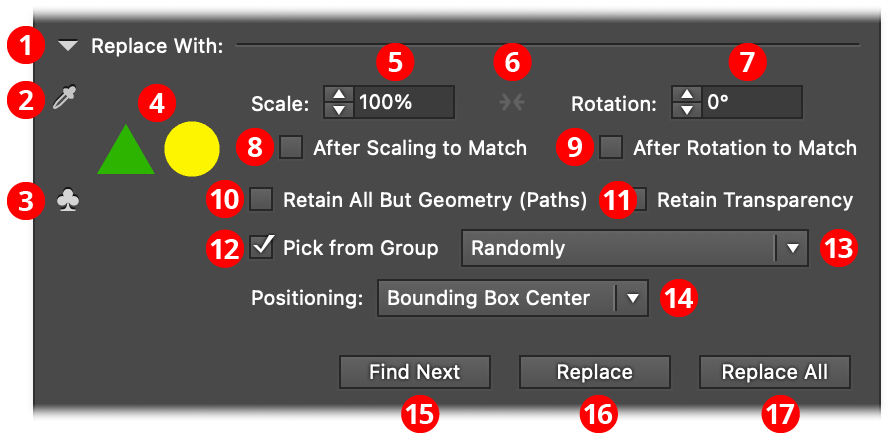
FindReplace Art Panel Replace Art Area
1. Twirl-Down
Shows or hides the entire “Replace With” section of the panel.
2. Replacement Art Eyedropper
When a single art object is selected, clicking the eyedropper picks up the art as the replacement art. To use multiple pieces of art, they must be grouped (see Pick From Group, below).
3. Symbol Menu
If symbols exist in the document, this menu allows one of them to be selected, by name, to serve as the replacement art.
4. Replacement Art Preview Area
Shows a preview of the replacement art for the current document. This art is stored along with the document and will be automatically loaded into the FindReplace Art panel whenever the document is opened. Hovering the cursor over the preview area will show a brief text description of the art, which can be useful for art such as single point or no-stroke, no-fill paths, which are otherwise invisible. Guides may be used as replacement art. Clicking on the preview area switches its background between white and the panel background color (it will be automatically changed to the panel’s background color if the replacement art is entirely white).
5. Scale
The amount to scale the replacement art, from 1% to 10000%. Ignored when the replacement art is a ruler guide. Scaling honors the general Illustrator preference Scale Strokes & Effects.
6. Scale and Rotation Reset Button
Resets the Scale value to 100% and the Rotation value to 0°.
7. Rotation
The amount to rotate the replacement art. Ignored when the replacement art is a ruler guide.
8. After Scaling to Match
When enabled, the replacement art is first scaled to match the original art before being scaled by the overall Scale value. Scaling is matched using the larger of the width or height of the unrotated preview bounding boxes of each piece of art, unless the original art is a simple two-point straight line, in which case the line’s length is considered its size. The replacement art’s aspect ratio is always preserved.
9. After Rotation to Match
When enabled, the replacement art is first rotated to match the original art before being rotated by the overall Rotation value. Rotation is matched using the internal rotation information that Illustrator maintains for each art object, manifested in its bounding box, unless the original art is a simple two-point straight line (in which case the angle from the line’s start point to its end point is considered its rotation) or a rectangle (in which case the direction of the first longer edge is considered its rotation). Unless it is zero, the internal rotation value of the replacement art is noted in the tip text shown when the cursor is hovered over the replacement art preview chip.
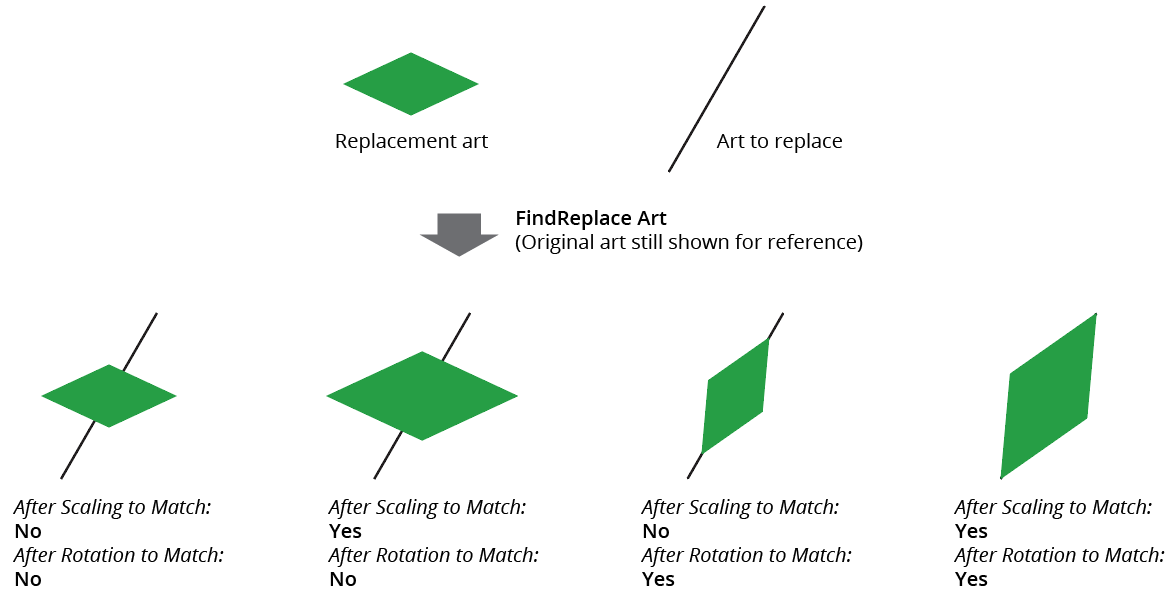
FindReplace Art Replace Match Example
10. Retain All But Geometry (Paths)
When enabled, and both the original art and replacement art are paths, only the geometry of the replacement art will be used; i.e., the style (color, stroke weight, etc.) of the original art will be retained.

Retain All But Geometry Example
11. Retain Transparency
When enabled, the replacement art will keep the Blending Mode, Opacity, and Opacity Masks of the original art.
12. Pick From Group
When enabled, and the replacement art is a group, then the original art will not be replaced by the entire group, but rather by one of the members of the group. Which member is chosen for the replacement depends on the subsequent pop-up menu setting.
13. Pick From Group Type
Specifies how the members of the group are used as replacement art:
Consecutively: Each member of the group is chosen in consecutive order, with the member at the top of the group’s internal stacking order being chosen first. After reaching the last member, the cycle restarts with the first member again.
Consecutively (reverse order): Same as Consecutively, but the member at the bottom of the group’s internal stacking order is chosen first.
Randomly: Each member of the group is chosen at random each time.
Randomly (once through): Each member of the group chosen randomly, but once chosen, that member will not be chosen again. If there are more original art objects than replacement group members, then some of the original art will not be replaced.

Pick From Group Type Example
14. Positioning
Specifies how the replacement art is positioned with respect to the original art. In all cases the alignment point of the replacement art is the center of its bounding box, unless it is a group containing a single-point path that has been named “align”, in which case that point will specify the alignment point (the single-point path will be omitted from the group when the art is replaced).
Bounding Box Center: The replacement art is placed such that its alignment point is at the center of the original art’s bounding box.
First Anchor Point: The replacement art is placed such that its alignment point is at the original art’s first anchor point. If the original art is not a path, Bounding Box Center is used.
Last Anchor Point: The replacement art is placed such that its alignment point is at the original art’s last anchor point. If the original art is not a path, Bounding Box Center is used.
All Anchor Points: The replacement art is placed multiple times such that each copy has its alignment point at an anchor point of the original art. If the original art is not a path, Bounding Box Center is used.
Bezier Handles: The replacement art is placed multiple times such that each copy has its alignment point at a bezier handle of the original art (if any). If the original art is not a path, Bounding Box Center is used.

When the replacement position is an anchor point, the rotation that will be matched is the tangent angle of the path at that point; if the point is a corner point, the rotation is considered to be the perpendicular to the imaginary line that bisects the angle that the point creates in the path. When the replacement position is a bezier handle, the rotation that will be matched is the angle of the handle.
15. Show Next Button
Highlights and centers the view on the next art object which matches the top search.
16. Replace Button
Available after the Show Next button has been pressed. Replaces the current matching art with the replacement art using the current options, and then (unless the Option/Alt key is pressed) advances to the next matching art. Holding down Shift while pressing the button causes the matching art to be retained rather than replaced.
17. Replace All
Replaces all matching art with the replacement art using the current options. Holding down Shift while pressing the button causes the matching art to be retained rather than replaced; if originally selected, the art that was retained is deselected unless the Option/Alt key is also pressed.
Illustrator Location:
Illustrator Main Menu > Window > Astute Graphics > FindReplace Art
For attributes which specify a gradient or pattern (such as a path stroke or fill), clicking on the color chip will being up the corresponding picker dialog.

FindReplace Art Gradient Picker
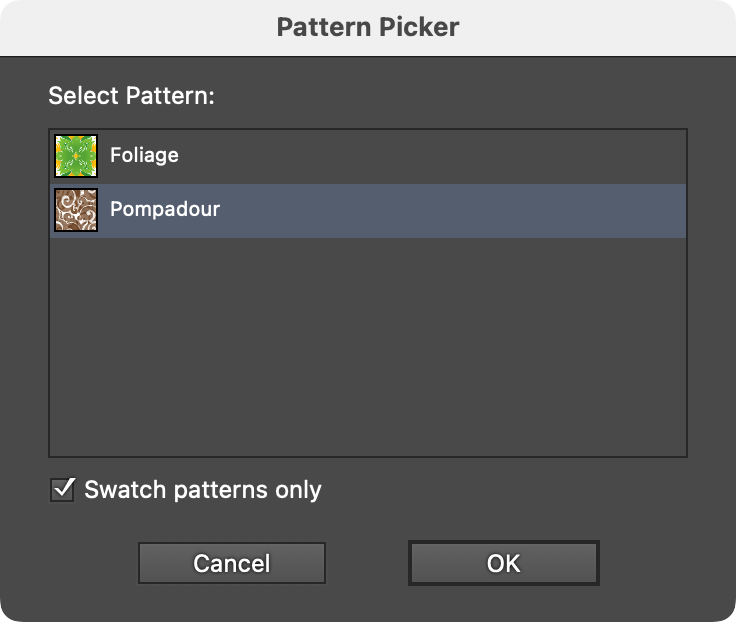
FindReplace Art Pattern Picker
In the Gradient Picker, Swatch gradients only controls whether only gradients that have associated swatches are shown in the list (there are often many unnamed gradients defined but not available as a swatch).
In the Pattern Picker, Swatch patterns only controls whether only patterns that have associated swatches are shown in the list.
Illustrator Location:
Illustrator Main Menu > Window > Astute Graphics > FindReplace Art > Panel Flyout Menu
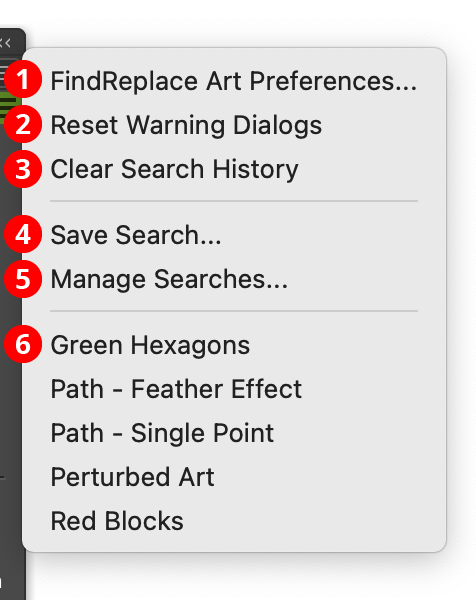
FindReplace Art Panel Flyout Menu
1. FindReplace Art Preferences...
Brings up the Preferences dialog (see FindReplace Art: Preferences).
2. Reset Warning Dialogs
Available if a warning dialog has been hidden using the Don’t show again checkbox; will make all warning dialogs visible again.
3. Clear Search History
Clears the history of completed searches that can be stepped through forwards and backwards with the navigation arrows in the top line of the panel.
4. Save Search...
Saves the search currently set in the panel to a file which can be recalled at any time later using the lower portion of the flyout menu. The Search Within setting is not included in the saved search. A dialog will appear, allowing you to name the search:
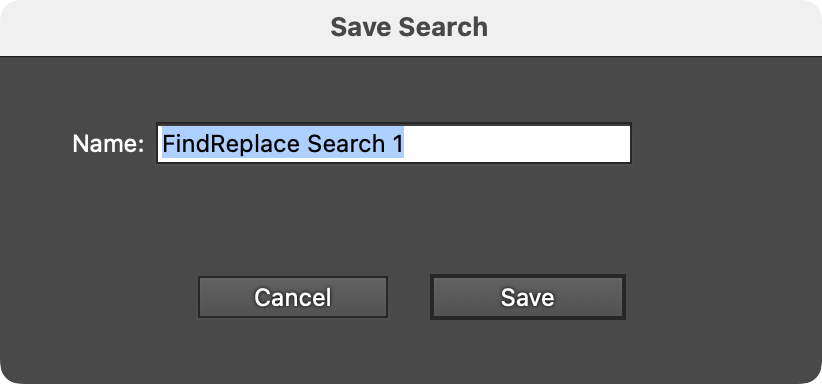
FindReplace Art Panel Save Search Dialog
5. Manage Searches...
Brings up the Manage Settings dialog, which lets you rename or delete saved searches:

FindReplace Art Panel Manage Search Dialog
6. Saved Searches List
Initially empty, searches which are saved will appear here in alphabetical order. Choosing a saved search from one of these menu items will load it into the top portion of the panel.
Illustrator Location:
Illustrator Main Menu > Window > Astute Graphics > Art Switcher
Art Switcher is an Astute Graphics panel that allows you to easily switch the positions of two (or more) art objects, both on the artboard and (optionally) within the layer/group stacking order. When switching, it allows the size of an object to be inherited from the object with which it was switched. The positions of multiple objects can also be randomized.
The menu item to show and hide the Art Switcher panel can be found in the main menu under Window > Astute Graphics > Art Switcher.
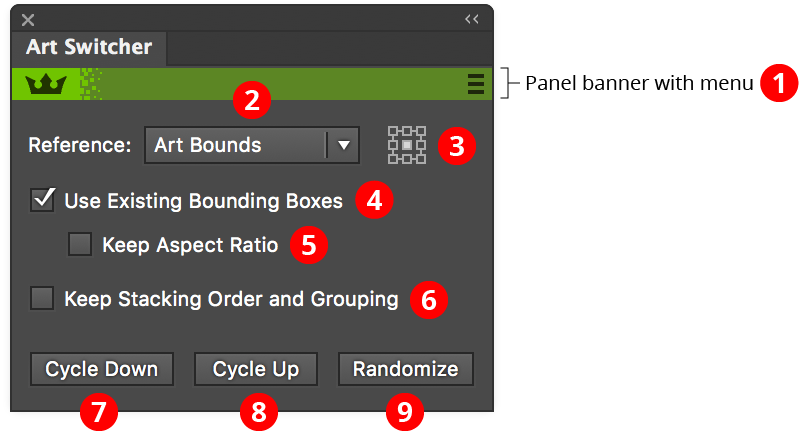
Art Switcher Panel Overview
1. Panel banner
The help button on the right opens the help documentation in the Astute Manager. If this does not automatically appear, please ensure your Astute Manager is running first.
2. Reference
The method for determining the reference point used to position the art objects during the switch. When set to Art Bounds, the bounding box of each object is used; the exact spot on the bounding box is specified using the nine-block control. When set to Art First Anchor or Art Last Anchor, the reference point is set to the corresponding anchor point of the path. If the artwork is a group, the bottommost path member is used. If the art contains no paths, the Art Bounds method is used regardless of the setting.
3. Reference Nine-block Control
When the reference method is set to Art Bounds, used to specify which spot on the bounding box is to be used: Top-Left, Top-Center, etc.
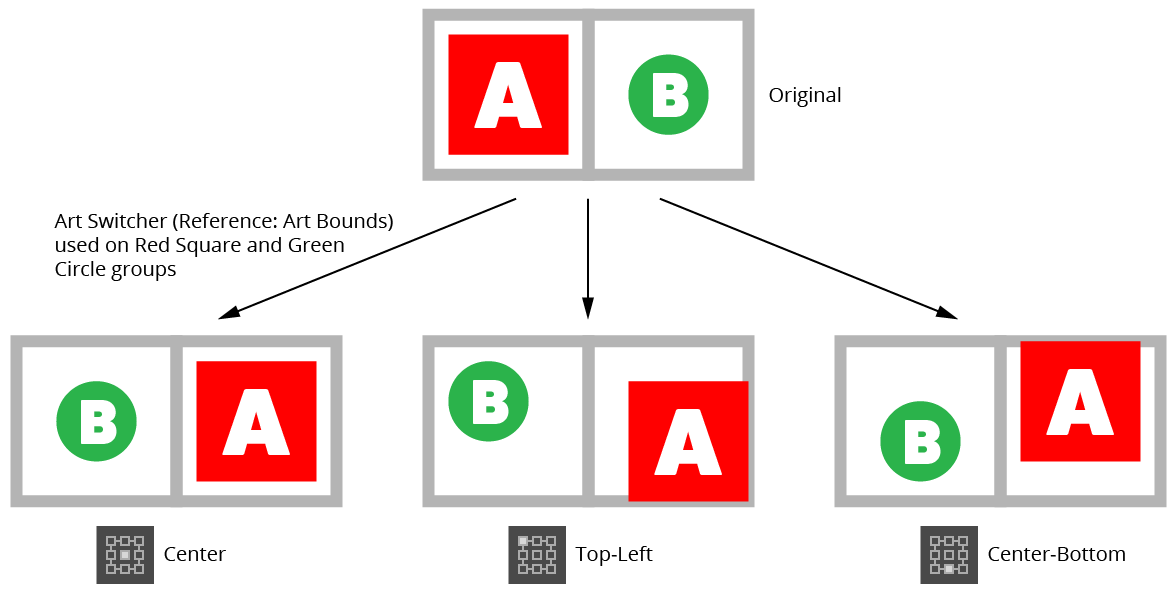
Art Switcher Panel Bounds Position Example
4. Use Existing Bounding Boxes
Objects will be scaled to adopt the bounding box of the object they are switched with. This may result in distortion if the objects have different aspect ratios. Clip groups will use the bounding box of the clipping path, not of the objects clipped by it, unless the clipping path has the string AGIgnore in its notes field (accessed through the Attributes panel).
5. Keep Aspect Ratio
When Use Existing Bounding Boxes is enabled, ensures that an object does not become distorted by forcing its aspect ratio to be retained (while still ensuring that the object fits into the switched object’s bounding box). Repeatedly switching with this setting enabled may therefore cause the objects to become smaller and smaller.
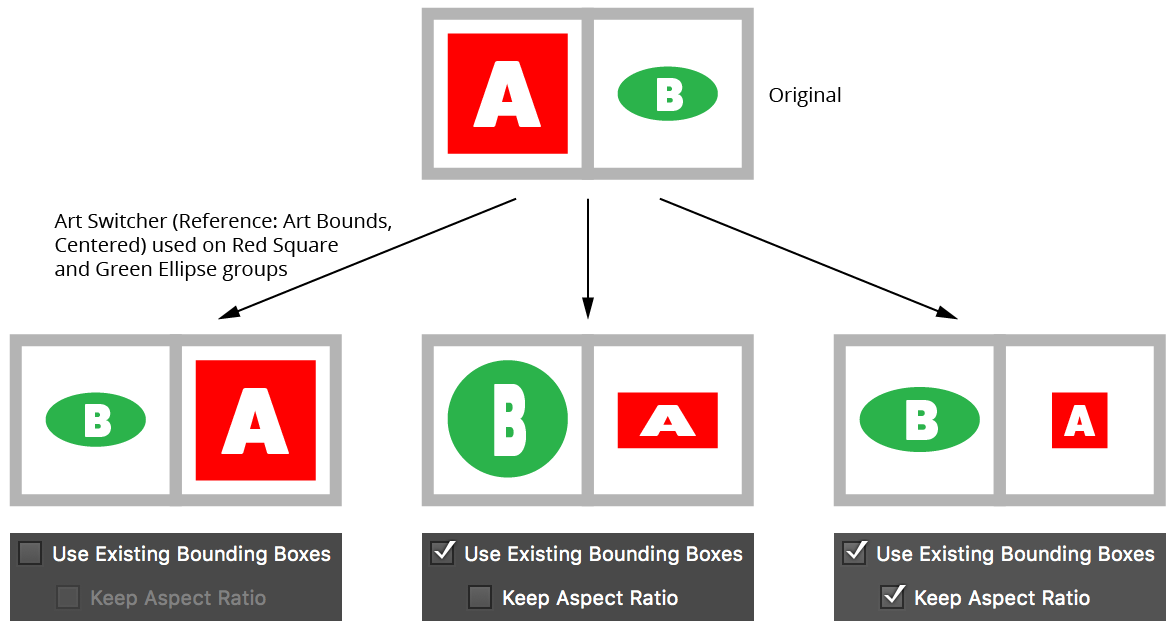
Art Switcher Panel Use Exisiting Bounding Box Example
6. Keep Stacking Order and Grouping
When enabled, only the coordinates and possibly size of the switched objects are changed; they remain in the same stacking order on the artboard and within the same group structure.
7. Cycle Down button
When switching more than two objects, specifies that each object should move to the position of the next selected object below it in the stacking order (except the bottom object, which switches with the top object).
8. Cycle Up button
When switching more than two objects, specifies that each object should move to the position of the next selected object above it in the stacking order (except the top object, which switches with the bottom object).
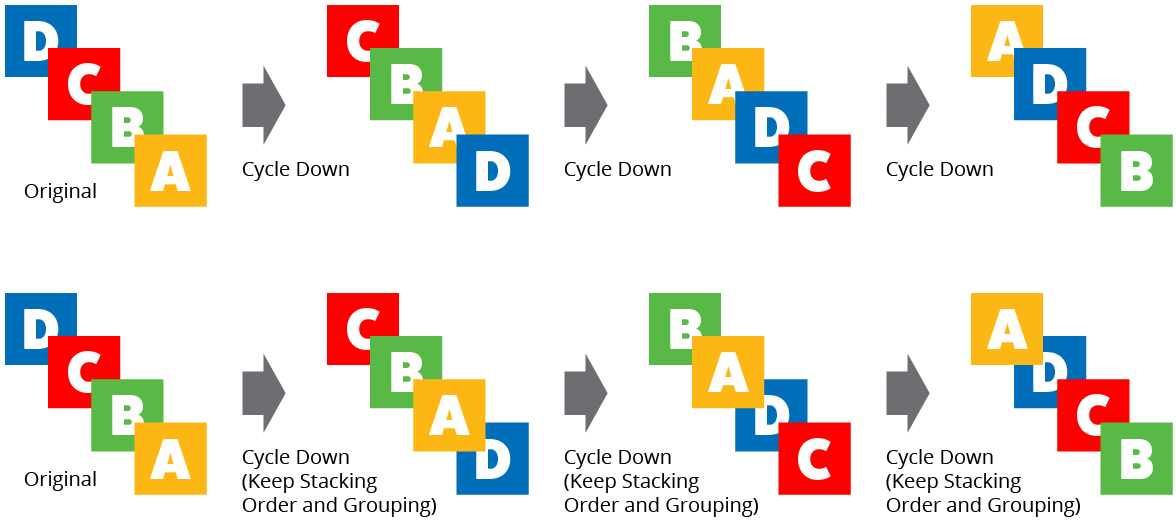
Art Switcher Cycle Examples
9. Randomize button
Each object is randomly switched with another selected object.

Art Switcher Randomization Example
